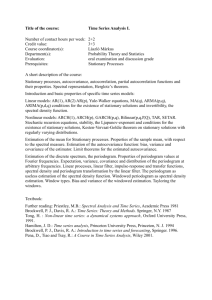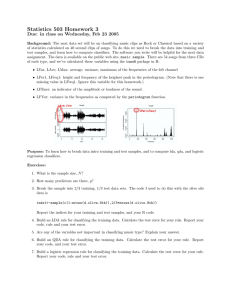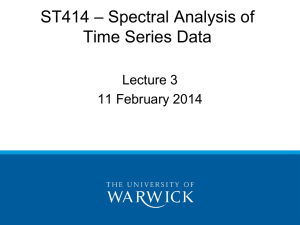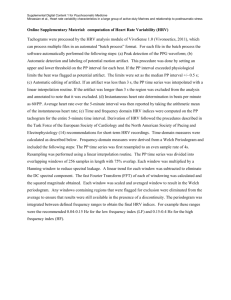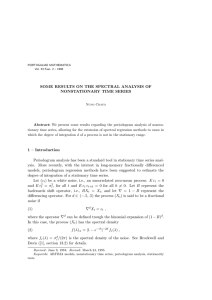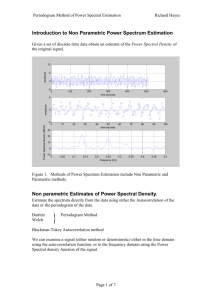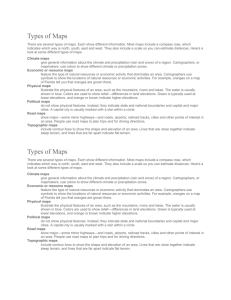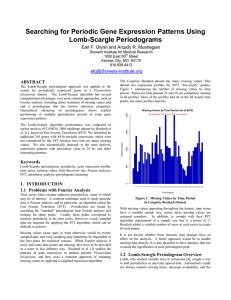PERIODOGRAM MODIFICATION AS A METHOD OF
advertisement
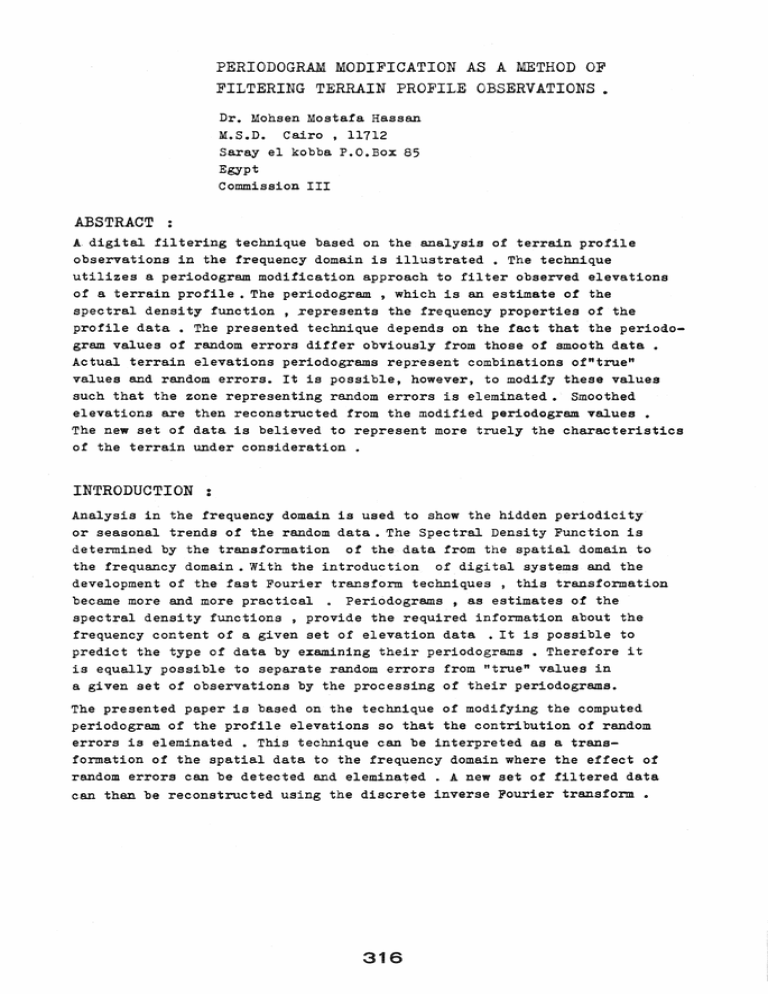
PERIODOGRAM MODIFICATION AS A METHOD OF FILTERING TERRAIN PROFILE OBSERVATIONS. Dr. Mohsen Mostafa Hassan MeS.D. Cairo, 11712 Saray el kobba P.O.Box 85 Egypt Commission III ABSTRACT : A digital filtering technique based on the analysis of terrain profile observations in the frequency domain is illustrated • The technique utilizes a periodogram modification approach to filter observed elevations of a terrain profile. The periodogram , which is an estimate of the spectral density function, represents the frequency properties of the profile data • The presented technique depends on the fact that the periodogram values of random errors differ obviously from those of smooth data • Actual terrain elevations periodograms represent combinations of "true" values and random errors. It is possible, however, to modify these values such that the zone representing random errors is eleminated. Smoothed elevations are then reconstructed from the modified periodogram values • The new set of data is believed to represent more truely the characteristics of the terrain under consideration • INTRODUCTION : Analysis in the frequency domain is used to show the hidden periodicity or seasonal trends of the random data. The Spectral Density Function is determined by the transformation of the data from the spatial domain to the frequancy domain. With the introduction of digital systems and the development of the fast Fourier transform techniques , this transformation became more and more practical • Periodograms , as estimates of the spectral density functions, provide the required information about the frequency content of a given set of elevation data • It is possible to predict the type of data by examining their periodograms • Therefore it is equally possible to separate random errors from "true" values in a given set of observations by the processing of their periodograms. The presented paper is based on the technique of modifying the computed periodogram of the profile elevations so that the contribution of random errors is eleminated • This technique can be interpreted as a transformation of the spatial data to the frequency domain where the effect of random errors can be detected and eleminated • A new set of filtered data can then be reconstructed using the discrete inverse Fourier transform • 316 This new set of elevations is believed to represent more accurately the true terrain elevations • The detection of the contribution of random errors in the periodogram is performed in accordance with the fact that noise has noticable values of the periodogram at high frequencies ( Fig. I ) • P(D<.) cut-off frequency I I contribution of random errors 11111iI! 1111111" ,111101"'1111,,11 ""l,,, ,1.'" ,,,'" Fig. I Typical shape of a periodogram that represents data contaminated by random errors • The periodogram can have a small bias even if the number of sampled elevations is large. Therefore, it is recommended to average together several periodograms that represent the same area of terrain • This idea will facilitate the use of the method in the bivariate mode to filter DEM data • In this case the DEM data of an area is subdivided into a number of equally spaced profiles • The periodogram can be determined for each profile separately , then an averaged periodogram is computed for the whole area • This averaged periodogram is used to determine the cut-off frequency t i.e. the frequency at which the periodograms of all the individual profiles will be truncated • This method ensures that the level at which the random errors are eleminated will be the same for the whole area • The smoothed elevations of each profile are determined from the inverse Fourier transform of the corresponding periodograms • 31 DETERMINATION AND Al~ALYSIS OF PERIODOGRA11S : The Spectrum of a set of discrete digital data is computed by applying the Fourier transformation technique • This frequency function ( the spectrum ) measures the average rate of fluctuation of the given observations, it also represents the distribution of power with respect to frequency. The spectrum can be determined as follows ( Schwartz,et.al ot 1975 ) : S(o<) N-l ::: L Zen ~d) e -jnbdo<. (1) n=o Where 0<. Z ~d N is is is is the the the the frequency at which the spectrum is computed • discrete elevation of the terrain profile sampling interval of the terrain profile number of data points in the profile • . . The spectrum is a complex periodic function with a period of 2 T , the magnitude of this function has even symmetry about the vertical axis at C>( ::: 0 • which The periodogram is defined as the magnitude squared of the discrete Fourier transform of the data divided by the number of the data points • The value of the periodogram at any frequency ~ is given by : 2 1 N SN (ex) \ The periodogram has the properties of a true spectrum as it is a positive function centered around the vertical axis of 0(::: 0 • Periodograms are usually determined for the reagon The periodogram of smooth data will have high values concentrated at low frequencies, while the values of the periodogram of random errors are small and distributed over all the range of frequencies • The reason of this phynomenom is that random errors are highly irregular in nature , therefore, their Fourier series converge very slowly and their periodograms do not diminish at high frequencies • It can , therefore , be stated that the values of the periodogram at lower frequencies are mainly due to the smooth elevations of the terrain profile • The effect of random errors in this zone of the periodogram is overwhelmed by the much greater effect of the true values of observations • 318 At some specific frequency in the periodogram the effect of the "true l1 values is very small so that it can be ignored, this frequency is called the cut-off frequency in the filtering process. The values of the periodogram at higher frequencies can be taken as the contribution of random errors only .. SAMPLING IIJTERV AL OF THE PERIODOGRAM : The periodogram values should be determined at intervals not greater than 2 ir/ (N-l) D. d • (Antoniou, 1979) • Throughout the present investigation it was found suitable to chose an interval of 2 Tr IN Ad , for the computation of periodogram points • The values of the periodogram should be determined for a number of points which depends on the characteristics of the terrain profile under consideration • This number of points should be sufficient to show all the range of frequencies at suitable interval. The number of discrete points for which periodogram values are computed is chosen to be equal to half the number .of data points • FILTERING TERRAIN PROFILE OBSERVATIONS : reconstruction of terrain profile elevations from their corresponding periodograms is feasible .. The inverse Fourier transform summation can be utilized as follows : ~he Zed) = 1 M... l N L m=o S(mAex.) e jdm b 0<... (3) If the values of SCm 6~) are modified so that the contribution of random errors is eleminated, it will be possible to reconstruct a set of elevations which are free from random errors • It is obvious that practically it is not possible to eleminate random errors completely because the remaining part of the periodogram after truncation is also influenced by the effect of random errors • The range of summation in equation(J) is determined according to the value of the cut-off frequency which is determined from the periodogram graph. It is now clear that the periodogram is used only to determine this cutoff value 9 while the reconstruction process is performed using the spectrum values in the range m=O to M-l . 319 CONCLUSION : Frequency domain analysis of terrain relief can be a useful diagnostic tool in analysing and smoothing digital elevation data. The method illustrated in this paper can be easily programmed using one of the well known Fast Fourier transform algorithms. It has the advantage of restoring the elevations in a smooth shape with minimum distortion due to filtering. Moreover, the filtering degree can be controlled by specifying the level at which the cut-off frequency is to be chosen • The use of the presented technique may also be extended to include the smoothing of any irregular curve that is sampled at equal intervals • The smoothing of digitized contour lines is a typical example of another application of the method • The spectral analysis technique can also be used in terrain classification as the periodogram of a profile or the averaged periodogram of an area is a compact way of describing the characteristics of the analysed terrain. In digital elevation models where the determination of the most appropriate sampling density is still a problem, analysis in the frequency domain proved to be useful ( Hassan ,1986 ) • REFERENCES : 1- Antoniou,A.,1979,"Digital Filters Hill,New Delhi,pp 523 • analysis and design", TATA McGraw- 2- Hassan,M.M.,1986,"A Spectral analysis method for estimating the sampling density of Digital Elevation Models",ISPRS,comm.III, From enalytical to digital symposium, International archives of Photogrammetry and R.S., vol. 26, Part J • J- Schwartz,iJ.,and Shawl,L.,1975,"Signal Processing" ,McGraw Hill Kogakusha , pp J96 • 320 9
